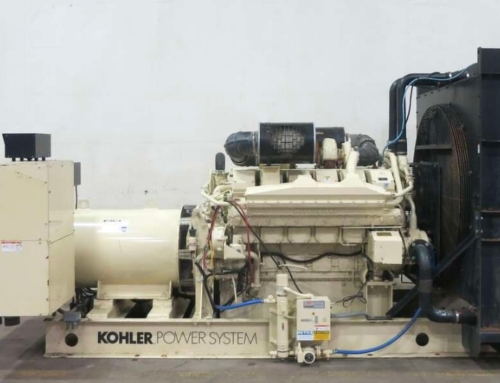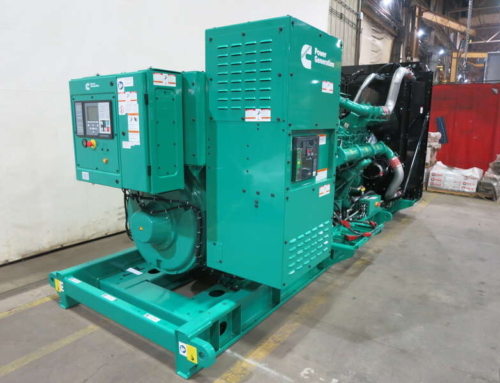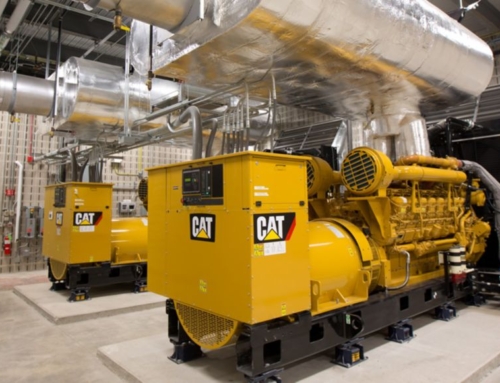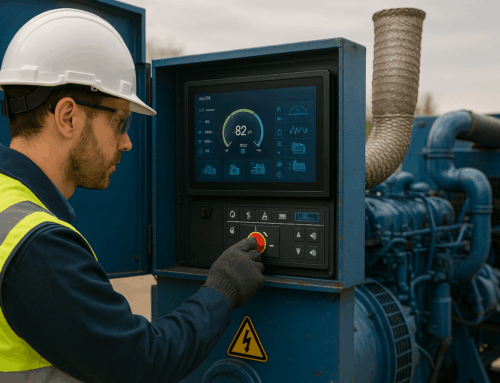Power stations, also referred to as generating plants, are usually attached to an electrical grid. They contain one or more generators and a rotating device that converts mechanical energy into electric energy.
In this guide, we’ll walk you through the role of power plant generators, their importance, and how a generator functions as a secondary source of electric energy in various power stations.
What Are Power Plant Generators?
Generators play a crucial role at a power plant. A power plant generator is a device that uses mechanical energy obtained from external sources to produce electricity. Multiple energy sources are used to turn the generator. They are broadly classified as renewable and non-renewable energy sources.
To meet the growing demands for electric energy, power stations need a continuous power supply to operate at all times. Many power stations use diesel generators to power facilities with nuclear, natural gas, coal, hydro, or other sources of energy.
These generators ensure a smooth flow of routine operations at power stations and act as a power backup during outages to keep the power stations running. They also help in ensuring the safety of personnel at power plants.
The Importance Of Diesel Backup Generators At Power Plants
Considering the valuable services power plants offer, a power outage can lead to significant consequences such as leakage of radioactive material, delay in production, etc. The best way to prevent damage due to extended power interruption is to utilize an emergency backup generator.
When it comes to the best option for backup generators, diesel generators are always a better choice than natural gas generators. As natural gas generators pose a fire hazard, businesses might have to switch them off during natural disasters to ensure safety. This causes a delay in power restoration.
Diesel generators, on the other hand, can restore power instantly and ensure a quick return to production. Research shows that diesel generates higher energy output per volume than natural gas. As diesel is less combustible, it also serves as a safer choice.
How Does A Power Plant Generator Work?
Generators usually utilize an electromagnet that is produced by a rapidly spinning turbine and electricity to generate huge amounts of electric power. Power plant generators can be broadly classified into two categories – those that utilize renewable energy and those that utilize non-renewable energy sources.
The majority of power plants use fossil fuels like oil, natural gas, or coal to produce electric power. Other energy sources include hydropower, nuclear power, etc. The type of main energy source defines the power plant type.
The uses of diesel backup generators differ based on the type of power plant. Let’s learn about them in detail.
1. Power Stations Using Renewable Energy Sources
Wave, wind, and hydroelectric power are the most widely used renewable energy sources to produce electricity. Solar radiation can also be utilized for power generation, but it does not include a mechanical or turbine generator.
1.Hydroelectric Power Plants
As per U.S. Energy Information Administration (EIA), hydroelectricity accounted for 28.7% of total utility-scale electricity generation in 2022. Generators have 2 main functions at hydroelectricity plants, one of which is providing emergency power backup.
A hydropower plant uses penstock to divert water flow into hydro turbines that spin to provide energy to the generator, which in turn transmits electricity. When there is a power shortage, the power plant generator might fail, and the plant cannot harness the water flow.
In such cases, backup generators help plants in continuing their routine operations for efficient hydropower generation. Diesel backup generators also support the functioning of spillway gates during a power outage. This helps spillways to protect hydro turbines and prevent flooding.
2.Landfill Gas-To-Energy Power Plants
The EPA data reveals that 70% of Landfill Gas-To-Energy (LGTE) plants generate electric power in the U.S. LGTE plants capture methane and other gases produced in landfills and convert them into sustainable energy using turbines.
Under this system, several wells connected by pipes are drilled into the landfill. These wells capture methane and other landfill gases and filter out byproducts and condensation. This gas is then sent to manufacturing units for further processing.
These power plants usually have diesel backup generators in place for emergencies or power outages to ensure uninterrupted services.
2. Power Stations Using Non-Renewable Energy Sources
Fossil fuels like natural gas, oil, coal, and nuclear fuel like refined uranium are the main non-renewable energy sources. Power plants using these sources are considered dependable energy sources as they can supply on-demand electricity.
1. Nuclear Power Plants
As per World Nuclear Association, nuclear power plants generate around 10% of the world’s electricity. These plants use steam and nuclear fission to create an electromagnet within the generator, which in turn produces electricity.
To ensure safety at nuclear power stations, having redundant and independent power sources that can keep the plant running during power outages becomes paramount. Diesel backup generators are widely used to supply emergency power to these plants during a loss of off-site power.
According to the Nuclear Regulatory Commission, emergency generators must restore power to safety systems within 10 seconds of a power outage. This regulation helps in preventing reactor core damage which ensures safety.
Diesel generators not only fulfill these requirements but can also withstand seismic events and climate conditions that can hamper the power grid connection. They also take care of other services in power stations, like system control, ventilation, and lighting.
2. Diesel Energy Plants
Electric power stations use diesel-fueled generators for an internal combustion process that converts diesel’s chemical energy into thermal energy to produce a mechanical action that generates electric power.
Mostly diesel plants are used as supplementary or emergency sources of power rather than primary power sources. As diesel burns up during combustion, a backup fuel supply is essential to support the emergency generator.
When there’s high electricity demand, diesel energy plants can be extremely helpful. For example, in situations like a widespread blackout, diesel plants can be used to reduce the pressure on the power grid.
3. Natural Gas, Coal, and Oil-Fired Power Plants
Fossil fuel power plants utilize non-renewable resources like coal, oil, and natural gas to generate power. These energy sources are first drilled from the earth, then refined or burned for electricity.
Coal and natural gas are among the top 3 energy sources for America’s electricity, making emergency backup power critical for fossil fuel power stations. As natural gas-fired plants lose less energy during conversion, they are more efficient than coal-fired power plants.
Generators play a crucial role in maintaining good efficiency levels at fossil fuel power stations and eliminating downtime during power shortages. In case of loss of a primary power source, generators keep the power plants running by powering important functions like battery charges, fans, critical pumps, hydraulic units, etc.
4. Diesel Power Plants
Being independent of a power grid, diesel power plants depend heavily on diesel generators to generate electricity. This means diesel must be stored in huge quantities as an emergency backup for power outages.
Some of the essential diesel power plant parts include the fueling system, the prime mover, and the lubrication and cooling system. The main function of the cooling system is to maintain the correct system temperature to avoid dangerous explosions or fire and damage to parts.
Although diesel power plant generators are widely used as a backup source for emergency scenarios, they can also serve as primary sources of power. In such cases, maintaining enough diesel fuel storage becomes even more critical.
Wrapping Up!
Being the key components of a contingency plan, generators help power plants in handling power outages confidently. Having a reliable backup generator can go a long way in mitigating the losses incurred due to extended interruption.
At CS Diesel Generators, we are committed to helping companies meet their generator requirements. Our team of experienced professionals can guide you in choosing the right generator that best suits your business unit.
Whether you’re looking for reliable backup energy or a new generator for your facility, CS Diesel Generators have multiple options for all your needs. Get in touch with us today, and we will be more than happy to guide you!
FAQs about Power Plant Generators
What is a black start process?
The black start procedure includes preparation for a partial or complete blackout to restore power without depending on backup energy from an external source.
What are switchyards and substations?
Considered the heart of the power plant, the switchyard serves as a sub-station that links the transmission system with the generating plant. It controls the exchange of electric power.
How much electricity can a power plant generate?
On average, a power plant can generate about 2,000 megawatts or 2 gigawatts of electricity by burning fossil fuels.
What are steam turbine plants?
Steam turbine plants utilize the dynamic pressure from expanding steam to operate the turbine blades. Around 90% of the world’s electricity is generated through steam turbines.
What are combined cycle plants?
Combined cycle plants use both gas turbines and steam turbines to generate electricity. While the gas turbine utilizes natural gas, the steam turbine utilizes the hot exhaust gas from the gas turbine to create electric power.









